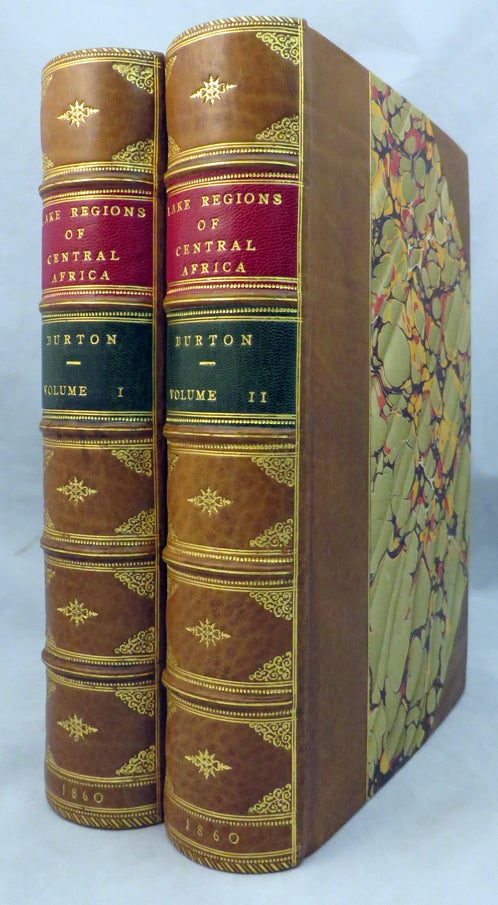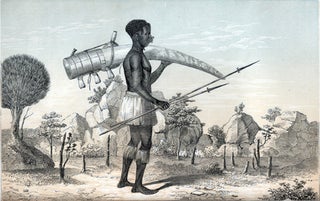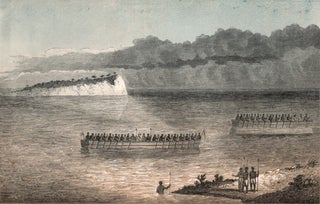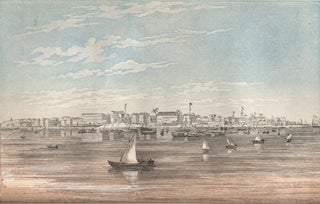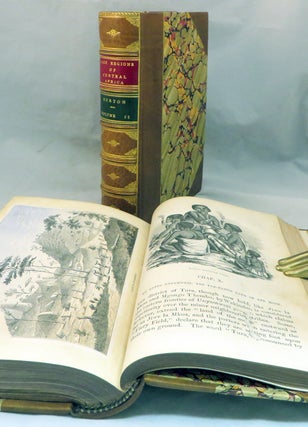THE LAKE REGIONS OF CENTRAL AFRICA: A Picture of Exploration
(London: Longman, Green, Longman and Roberts, 1860).
SCARCE FIRST EDITION of a book which to this day is considered one of Burton's very best. Burton returned to Africa, after his expedition to Harrar, to undertake an exploration of the "then utterly unknown Lake regions of Central Africa." His stated intention was to correct certain geographical errors (of which there were many at that time) concerning Africa and to survey as fully as possible the resources of Central and intertropical Africa. But the real reason he wanted to venture into that unknown wilderness was to find the Jebel Kumri, the fabled "Mountains of the Moon," and to find the source of the Nile river.
Burton and Speke first stopped at Zanzibar, then explored the coastal regions around Mombassa, and returned to Zanzibar, from whence they set out for Ujiji--about a thousand miles inland, on the shore of the relatively unknown Lake Tanganyika. It took seven and a half months to arrive, and when there they explored the lake ineffectually due to their wretched physical condition and the unwillingness of the natives and Arab traders to assist them. Upon the point of the direction of flow of a certain river attached to the lake--whether it flowed into, or out of, the lake--they received conflicting information from locals.
They returned to Kazeh, two-hundred and sixty miles east, where they recovered somewhat their health, and Burton sent Speke alone to investigate a large lake that the Arab traders had said lay fifteen or sixteen marches to the north. Speke visited the lake briefly, obtained some vague information from the locals, and decided he had discovered the true source of the Nile, a decision that "would affect men's careers and lives and lead to his own death," as Edward Rice puts it (p. 310). After Speke's return from the side-trip, the expedition returned to Zanzibar.
This expedition into Central Africa was perhaps the most taxing of Burton's career; his journey to the Holy Cities of Arabia was a cake-walk by comparison as far as physical hardships were concerned; and the storm of geographical controversy that greeted him upon his return to London, where he found that
Speke had published his erroneous conclusions and attached all the glory of the expedition to himself, left Burton "disgusted, desponding, and left behind in the spirit and in the flesh," according to his old friend, Alfred Bate Richards.
Burton returned to Africa, after his expedition to Harrar, to undertake an exploration of the "then utterly unknown Lake regions of Central Africa." His stated intention was to correct certain geographical errors (of which there were many at that time) concerning Africa and to survey as fully as possible the resources of Central and intertropical Africa. But the real reason he wanted to venture into that unknown wilderness was to find the Jebel Kumri, the fabled "Mountains of the Moon," and to find the source of the Nile river. Item #22454
2 volumes. First edition. With 12 chromo-xylographic tinted plates, 22 woodcuts and one folding map. Large 8vo, very handsomely bound in fine period style three-quarter tan calf over marbled boards, the spines beautifully gilt tooled with panel designs, gilt ruled and stippled compartments between gilt ruled raised bands, two compartments with contrasting labels of red and green morocco lettered and ruled in gilt, end-leaves marbled, t.e.g. xvii, 412; vii, 468. A handsome set, internally clean and fresh, all quite solid, the period style bindings are very fine.
